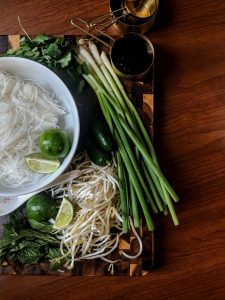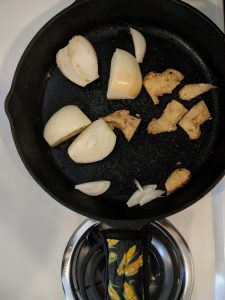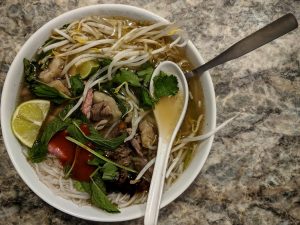Oxtail Pho
By Chase_Day • December 14, 2018
It took not one, not two, not three, not four, not even five knocks at the door—but six. It took six knocks at the front door before my friend Billy, a Vietnamese-American whom I first met belting the words of A-Ha’s “Take On Me” out of the driver’s side window of a blue Toyota Yaris that was missing all but one hubcap, decided to open up. And there I was. Standing on his front porch holding a stock pot I had “borrowed” from the local Episcopal housing on campus. The pot was almost larger than my entire torso. All that Billy could see was a giant silver pot with two long human legs. Billy found this hilarious. He left me standing on his porch holding a pot of steaming broth as he laughed for a good thirty seconds before he let me come inside.
I take the pot into the kitchen, set it on the stove, and then begin to take all of the pho fixings out of my backpack and onto his countertop. Billy immediately starts taking inventory. He calls out each. Rice noodles, scallions, limes, peppers, sauces, roots (which I learned later were what I called bean sprouts), and meats—everything was accounted for. After, he marches right up to the giant stockpot resting on the stove, exhales sharply through flared nostrils, lifts the lid, and whiffs—whiffs with the strength of ten men.
And before I could prepare myself, before I could make any effort to brace myself for whatever came next, Billy smiled.
Not only did Billy smile, but the corners of his mouth reach across his cheeks so fast you could almost hear his lips part. He hits me with a, “Nice,” a universal symbol of approval, and then stops for a moment, presumably taking a moment to think. Afterwards, he hits me with another, “Nice.”
The energy in the room changes immediately.
Billy excitedly brings out a large blue plate and begins to arrange the ingredients for serving soup. He pays close attention to where each item is placed and does this diligently with a special emphasis on presentation—just as a painter might arrange a palette before starting on a fresh canvas. “It’s all about the beauty,” he says jokingly, although I can tell there’s a tinge of honesty and conditioning behind his humor. Billy then takes out a cutting board and chops the jalapenos and scallions. He washes the knife and the cutting board between each. After asserting that the broth must be, “piping hot,” he turns on the stove and we take a seat in his living room.
Billy paces back and forth like a child on Christmas Eve. I mean, this grown man is actually bouncing around the house. He runs from the kitchen to the living room and then back again, repeatedly, in anticipation. When it’s hot enough to eat he shouts to me, and before I could even make it to the kitchen he’s got a bowl in hand and is already ladling out broth with a small spoon so fast you’d consider it a sport. As he starts to assemble his bowl he begins to narrate the process.
“You want enough broth to cover everything that’s going in,” “Make sure you wash your hands before touching the noodles,” and “Don’t add too much fish sauce.” He repeats the last one several times. It all sounds rehearsed—a sort of inner dialogue—but does not necessarily come across as commanding. We both finish making our bowls and set down at a low table on his living room floor.

I’m staring at my bowl and at his, and they look wildly different. I’m afraid I’ve done something wrong until I see Billy’s face. He turns to me, bright-eyed and ecstatic, and thanks me.
Before his first taste he stops to tell me, “This is special. This is made with love.” Billy finishes three bowls before I finish one. Afterward, he belches loudly, sprawls out on the couch, and releases the loudest belch I’ve heard in my whole 21 years.
“That’s a good sign! Says that I am full!” he laughs. The man is practically radiating satisfaction.
So, where did I go right?
Well, first of all, I listened. I came to Billy one night the week before, sat down with him, and just listened. What’s in your pho? I ask.
He goes on to explain all the do’s of making a good pho. But surprisingly, he leaves out the don’ts. He harps on using thai basil, and if that’s not accessible, to substitute mint instead of sweet basil. Use scallions but if you don’t have scallions use green onions. Do use the little brown cubes (bullion). Do include jalapenos, but only if you can’t find chilis. Do use oxtail.
This is where I stop him. Oxtail? I’d never heard of oxtail before. What did it taste like? What did it smell like? At first, I assumed we were talking about a spice. Something I could find in a plastic grinder right next to salt and “Italian seasoning” at a local grocery. When he realized I truly had no idea what he was talking about, he chuckled heartily. It’s the tail! Of an ox! The literal tail of an ox! And this, he insists, is the only necessary ingredient. It’s the only thing you don’t substitute.
And that’s when I realize that making good pho is largely a choose-your-own-adventure type process. It’s what you like, and how you like it. And thankfully, there’s no special technique or complicated composition. Like all good things in life, good pho takes time. But luckily that’s all it takes. Time.
So what do I like?
Everything. In terms of food, I’m a maximalist. The more the merrier. I’ve joked many times that my taste buds have been broken for years.
“It all tastes good!” I joke.
But with pho, that really is the case. I wanted it all. The full-bodied experience in 1080p on a large flat screen with surround sound speakers and a reclining chair. I wanted the whole 9 yards. I wanted oxtail.
And this is how I did it:
BROTH
2 tablespoons fish sauce
1 teaspoon coriander seeds
4 cloves
1 teaspoon fennel seeds
1-2 cinnamon stick(s)
1 large carrot
3 star anise pods
1 large onion
1 large piece of ginger (around 5 inches)
2 pounds oxtail, sliced into ½ to 1 inch chunks
1 tablespoons salt
½-1 tablespoon sugar
SERVING
1 pound banh pho noodles (dried rice noodles)
1 pound beef top sirloin, thinly sliced
2 to 3 cups mixed herbs (cilantro, Thai basil, mint)
2 to 3 cups bean sprouts
½ cup scallions
Thinly sliced Thai chilis (I’m substituting jalapenos)
2 limes cut into fourths
Hoisin sauce and Sriracha to taste



Begin by preparing your oxtail. To do so, I placed them within a large pot, covered with water, and brought the water to a boil. Let this boil for around 15 minutes. In this step, you’re looking to clean the impurities from the oxtail. You’ll start to see them rise out of the meat and settle on top of the water. Think your meat is clean enough? Cool. Empty the water and set the oxtail aside. Check for any impurities or anything out of the ordinary.

Next, you’ll want to sear the onion and ginger. To do so, cut both into chunks. I quartered the onion and cut the ginger haphazardly. Don’t think about it too hard. Heat both in a skillet at medium-high heat until charred. This’ll take around ten minutes. I did this while waiting on the oxtail to boil.


After searing the onion and ginger you’ll want to prepare your aromatics. Combine the spices (cloves, star anise, coriander seeds, and cinnamon) into a skillet and heat gently (low to medium heat) until you can smell them. You’ll know pretty quickly what smell you’re looking for. For me, this took around 3-5 minutes. It might look something like the picture below. After this step, I chose to combine the aromatics into a tea bag for easy removal.

Here comes the fun (and easy!) part. Combine the oxtail you’ve set aside earlier, ginger and onion, carrot, and aromatics into a large pot. Cover with around 6 quarts of water. Add the fish sauce, fennel seeds, sugar, and salt. Bring to a boil, reduce to a simmer, and cook. For at least 6 hours. Yes, you read that right. 6 hours minimum.
At some point, you may be inclined to remove the meat. After an hour and a half or so, the oxtail will become tender and may begin to fall apart. If you’re worried about this, just remove it and set it aside for later. You’ll be using this meat in your pho, so carefully shave off the salvageable pieces and be careful to avoid bones and gristle. This is difficult and likely messy, but stay patient. I’d include pictures but my hands were quite literally covered in fats and miscellaneous meat juices and my sink looked like a bad Hollywood murder scene. I’m convinced there’s no right way to remove the meat from the tail bones. The broth might look something like this around the time you’d take the meat out:

After 6 hours you should have a nice, brown broth that looks something similar to this:

Remove everything floating around in the broth and discard it.
Prepare the ingredients for serving. Quarter the lime, slice the scallions and chilis, remove the coriander and mint stems (or don’t). Arrange these ingredients along with the beansprouts and sauces onto a single communal dish.
Slice raw sirloin into small slices. I find it easier to place the raw meat into the freezer for maybe 15 minutes before slicing. It hardens the meat so you can easily cut it into fine pieces. Set aside.
Heat your rice noodles. Depending on what you’ve purchased, instructions will vary. For the noodles I used, I poured boiling water over them and let sit for around 10-15 seconds before I removed them.
Here’s the next fun part! (Okay, this one truly is fun, trust me.)
Remember earlier how I described Billy as some sort of artist as he arranged the pho ingredients? Well now it’s your turn. Pick your biggest bowl and spoon, and begin your artistic process.
Place the noodles into the bowl, add slices of the oxtail you’ve prepared earlier, raw sirloin, and bean sprouts. Pour the hottest broth you can manage over the bowl. Doing so should cook the sirloin over time. From here, the process is truly up to you. This is your bowl.
Add mixed herbs to taste, along with the lime. Squeeze in the juice if you’d like. Or don’t. Have fun. Taste it. Remind yourself why you have taste-buds.
Add hoisin sauce and sriracha to taste—but do it in style. How would Jackson Pollock paint his pho bowl? Taste it again. And I mean, really taste it. Think about the individual flavors swirling around in your bowl. Can you single out any specific flavors? What do you like? What do you hate? Take note, and enjoy. You’ve earned it.

CONDENSED INSTRUCTIONS
- Begin by searing the onion and the ginger. To do so:
- Heat a skillet to medium-high heat.
- Add onion and ginger, stirring occasionally.
- Continue to cook until blackened on all sides, about 10 minutes.
- Prep for the broth as follows:
- Combine oxtail into a large pot.
- Cover with cool water, bring to boil over high heat.
- Continue to boil for around 15 minutes.
- Remove meat and dump water.
- In this step, you’re cleaning the meat. Check the meats used for debris and keep a careful eye for anything out of the ordinary.
- Return meat to pot and again cover with cool water.
- To cook the broth:
- Here, we’re adding several ingredients to our broth. This is a long list—don’t forget anything:
- Charred onions and ginger
- Star anise
- Cinnamon
- Fennel
- Cloves
- Coriander
- Fish sauce
- Sugar
- Salt
- Bring to boil over high heat, reduce to a simmer, and cook.
- Pay careful attention to the meats as they cook. You want the meat to turn tender but not to fall apart. This should take about 1 ½ hours.
- When meat is tender, remove meat from the pot and set aside.
- Simmer:
- This is the most important step in making your pho. Remain patient, and keep an eye on your broth. Simmer for at least SIX hours. They’ll know if you take shortcuts.
- Strain broth through a fine colander.
- Discard aromatics and beef pieces.
- Do not cool broth. Keep hot.
- Skim fat from the surface of the broth as well as possible, if needed. (Mainly pertains to reheating the broth)
- Here, we’re adding several ingredients to our broth. This is a long list—don’t forget anything:
- Prepare beef sirloin.
- Slice into fine thin slices. To do so:
- Place meat in freezer to harden, about 15 minutes.
- Slice thinly, against the grain of the meat.
- Prepare pho noodles.
- Most noodle packages will come with a set of directions. Follow them. Good luck.
- Slice into fine thin slices. To do so:
- Serve.
But what if I don’t know how to serve pho?
- Place all ingredients listed for serving in the middle of your table.
- Place noodles and a serving of raw meat (don’t worry, the hot broth will cook the meat) into a bowl.
- Pour hot broth over.
- Prepare your bowl as you please.